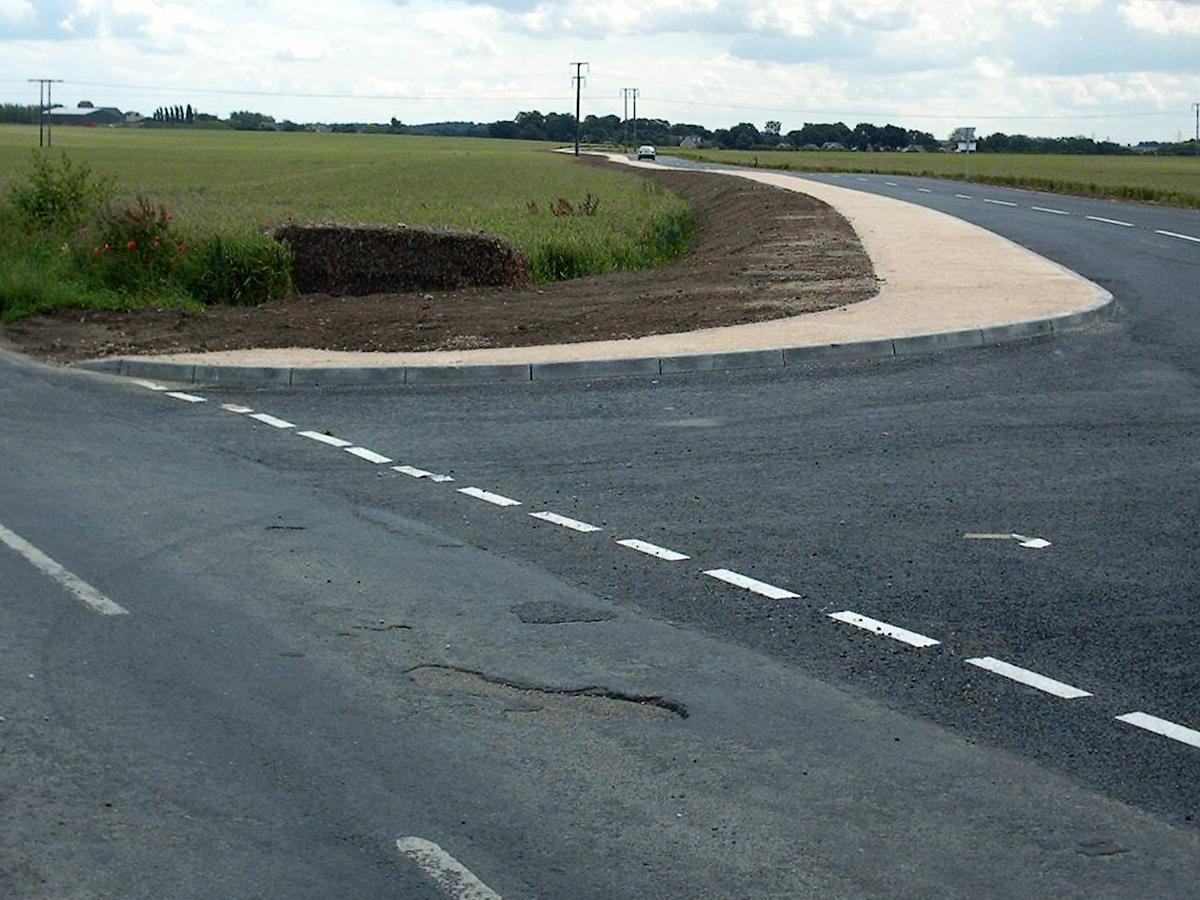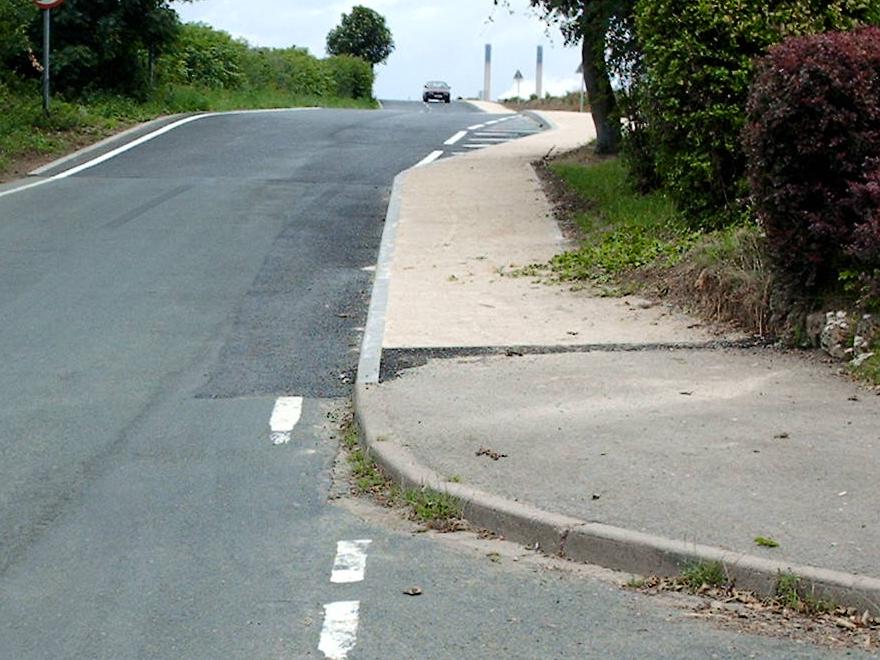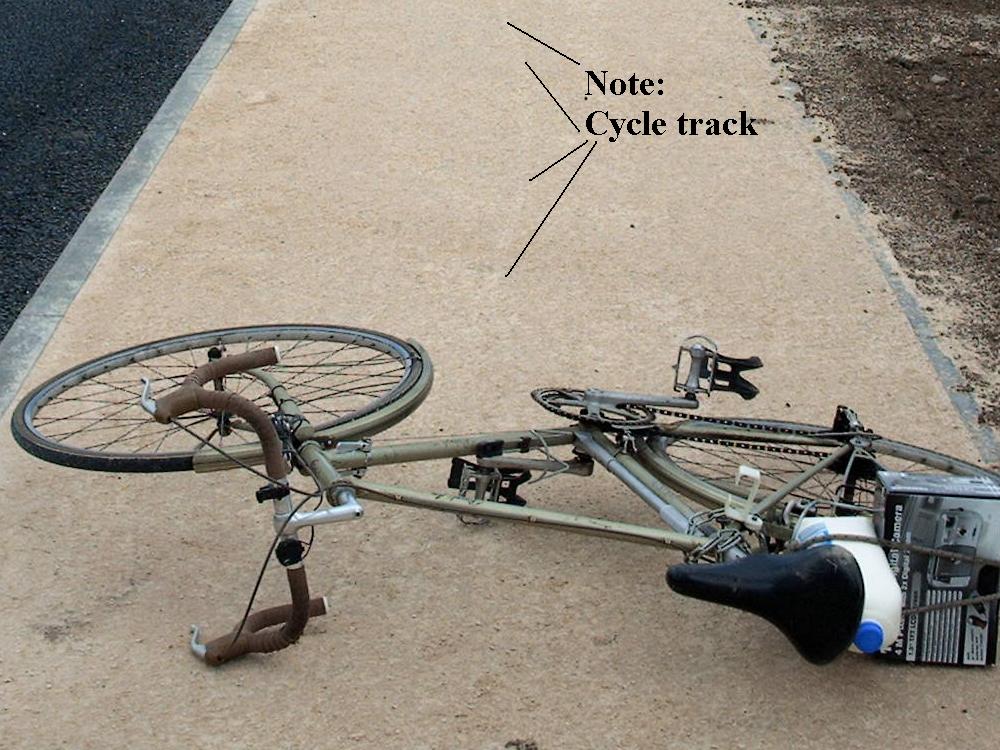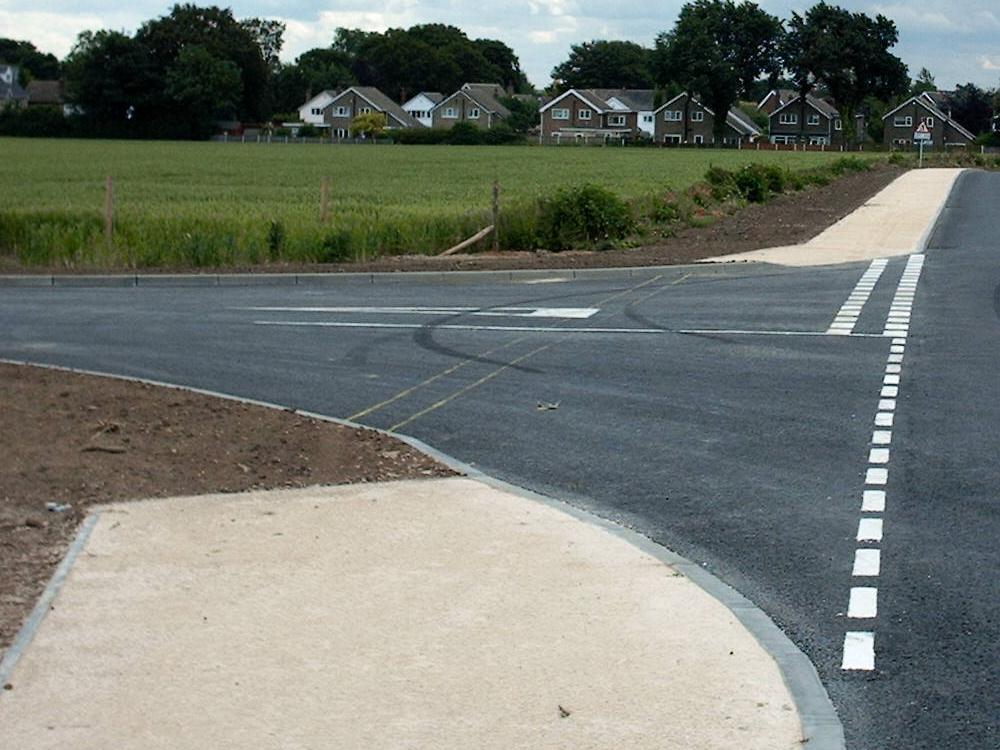
May 20th 2004
By Steve Kidd steve_jm_kidd@yahoo.co.uk
The following photographs typify the success that Pontefract and the world’s cyclists are having with Wakefield Metropolitan District Council.
They come from less than a one mile section of a road called Baghill Lane or Marlpit Lane, all a supposedly contiguous part of the West Yorkshire 'Cycleway'.

Map: Pontefract (West), West Yorkshire
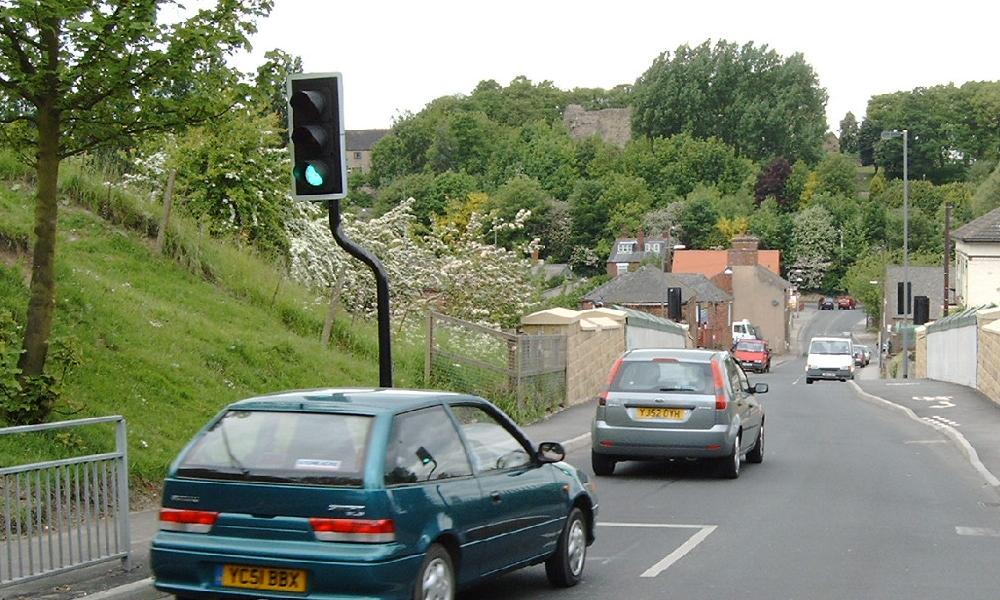
Picture 1 shows Baghill Bridge, which had been shut to motor traffic for six months, while it was strengthened. As you can see, cyclists now have to give way at the lights, despite there being ample room to let them through.
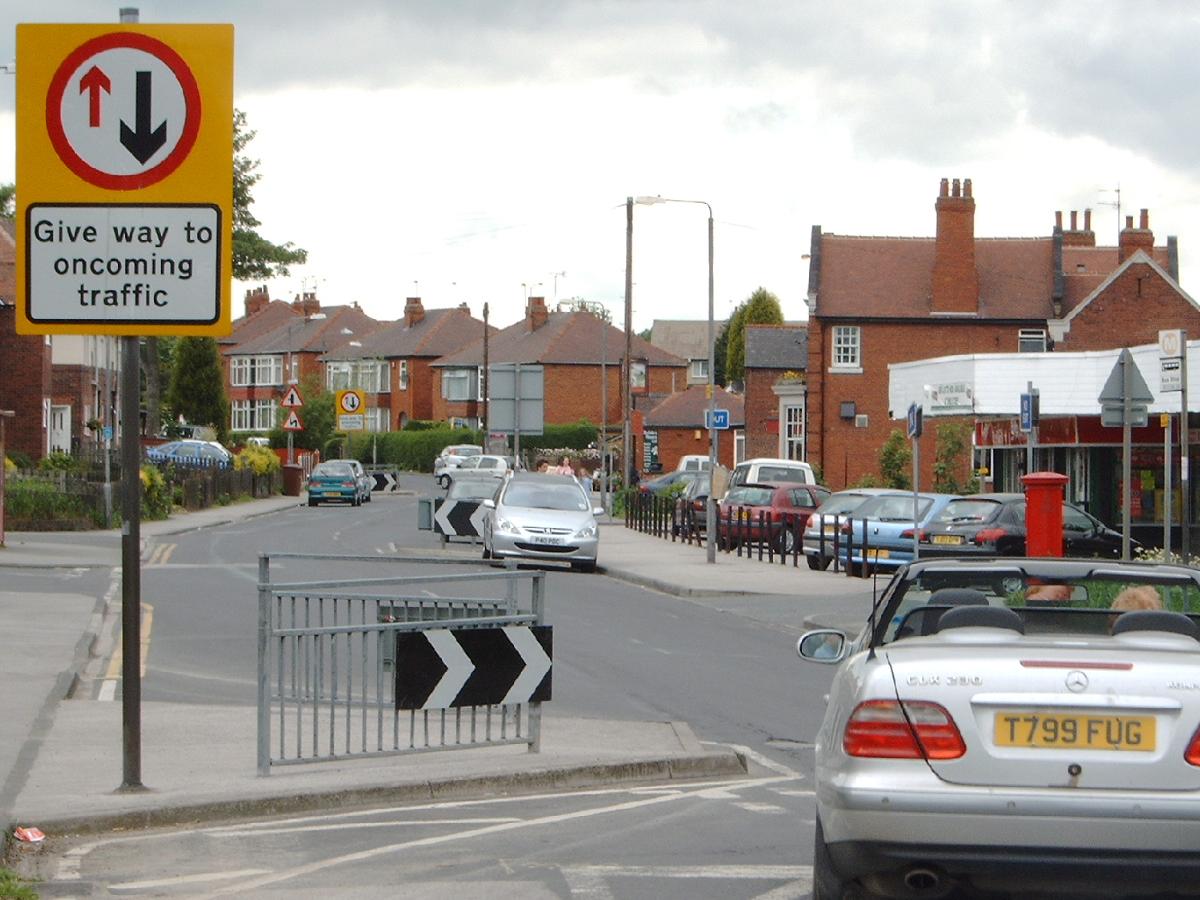
Picture 2 shows build outs into the road. Cyclists, once again, have to give way to oncoming traffic, and are extreme danger from traffic flowing the same way as they are forced to swerve in and out seven times in the space of 500 metres. This was bought to the attention of Newton Bar several years ago. The fact that any body apart from the most docile moron would actually allow cyclists a straight path is endorsed by the fact that build outs in, for instance, Airedale estate, allow cyclists to proceed unhindered.
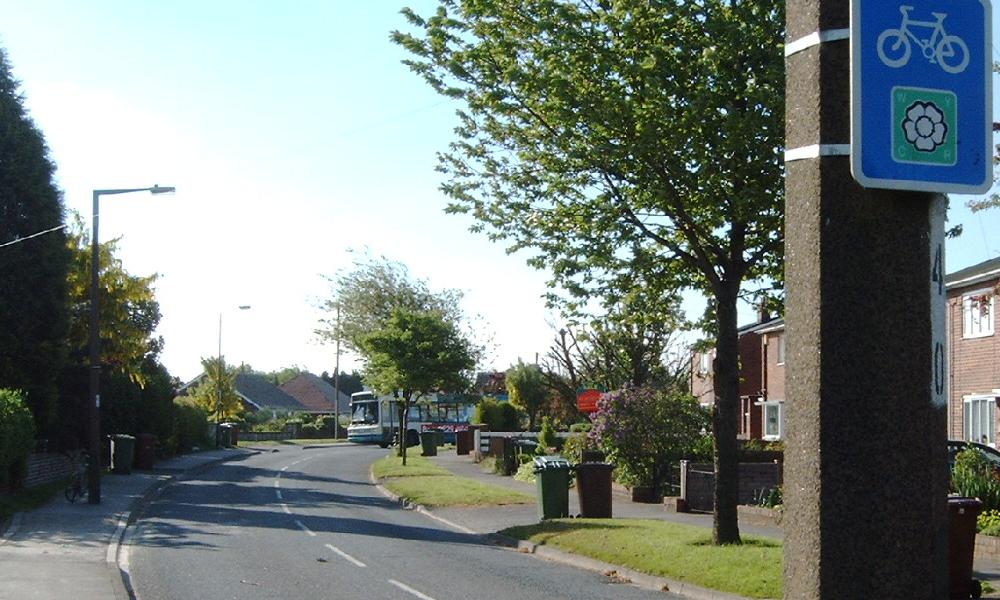
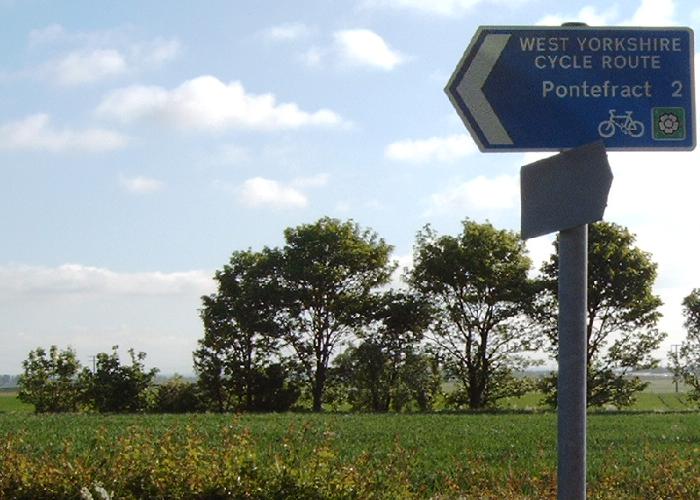
Pictures 3 and 4 indicate that the West Yorkshire Cycleway is open for business in both directions.
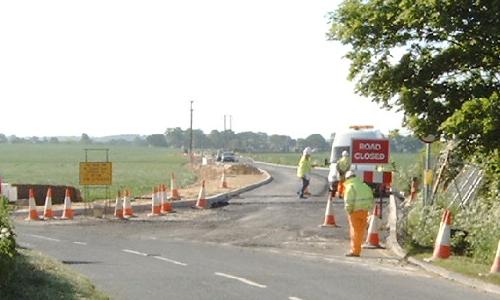
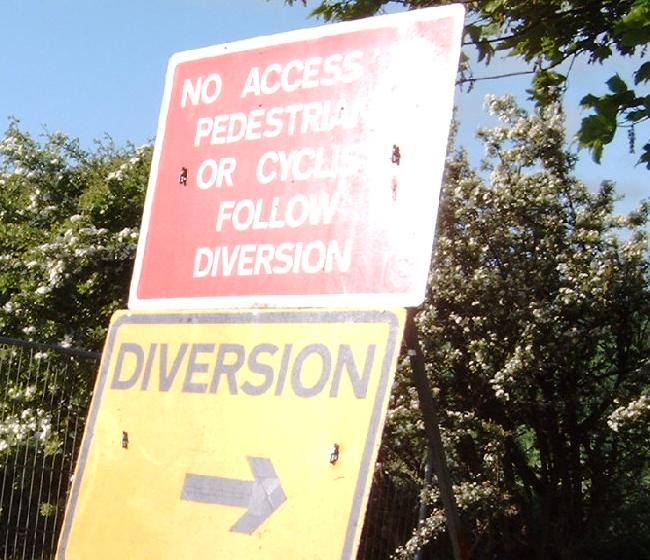
Pictures 5 and 6 show that the route is completely closed for four months. Criticisms and questions include:
I would be interested to hear from anybody who can tell me anything credible which WMDC have done for cyclists in Pontefract. The sad thing is that I only get letters telling me I’m going about things the wrong way. Could somebody please explain what makes the images above the right way?
Here is a comprehensive collection of what has been achieved in Pontefract to achieve the National Cycling Strategy targets:
dick
June 8th 2004
WMDC’s responses and my replies.
The first letter is from Peter Hemming and has a point by point response. The second is from Andrew Spittlehouse and has a more broad response (I really have got better things to do with my own time than argue with people who get paid to deny that they collectively provide a sub-standard service)
| WMDC email | Response | |||||||||||||||||||||||||||||||||||||||||||||
|---|---|---|---|---|---|---|---|---|---|---|---|---|---|---|---|---|---|---|---|---|---|---|---|---|---|---|---|---|---|---|---|---|---|---|---|---|---|---|---|---|---|---|---|---|---|---|
Subject: Cycling - in Pontefract Steve, You wrote an email which Andrew Spittlehouse received. I am replying to that email.
Anyway it is so nice to know that you consider 1 meter is two narrow for cycles, that wipes practically all your cycle routes off the map. I take it we can look forward to seeing this done?
I get tired of repeating this:
“who can tell me anything credible which |
Letter #2
Subject: RE: Cycling - in Pontefract Steve
further to the message recently responded to by Peter Hemming (Travel
Awareness Manager), I would like to add a few comments re transport
policy.
As you may be aware I am the Acting Team Leader for the Transport
Strategy team is based in the Spatial Policy Unit within the Housing and
Regeneration Service of WMDC. The team is responsible for the Local
Transport Plan (LTP), which is the bidding document for funds from
Government, and the Annual Progress Report which reports progress against key
indicators. We are also responsible for the formulation of transport
policy. Implementation of schemes using capital money is the responsibility
of the engineers in the Environment Service. The implementation of
schemes should be in line with the objectives and programme outlined in the
LTP.
With regard to provision of facilities in Pontefract, the Pontefract
park cycle route has been identified for improvement in the 2004/05
financial year. Proposals to upgrade the surface are being developed as well
as signing. Links are also to be developed into the Freeport site in
subsequent years. This programme is subject to agreement from all the
affected parties, although no objections are anticipated.
Subject to an assessment of safety and provision of necessary feeder
cycle lanes, advanced stop lines may be included in improvements to the
Skinner Lane / Northgate junction. Other improvements will upgrade
facilities for the disabled and other pedestrians (tactile buttons, dropped
kerbs etc). In the future all upgrades to junctions and new junctions
across the district should be subject to cycle audit. Both the cycle
officer and various traffic engineers have been involved in the CTC
sponsored Benchmarking Project which began earlier this year. They have
already visited Harrogate and will visit other local authorities to look at
examples of good and bad practice with regard to cycling provision. It
is hoped that this will improve the quality and amount of facilities
provided for facilities in the district.
Although I would agree that cycle facilities should have been
considered for the Baghill Lane bridge, I would concur with Peter that safety is
paramount and that facilities are not always possible, that otherwise
seem simple to implement.
Although the LTP is a 5 year programme, adjustments need to be made
over the course of the plan to account for schemes that are delayed or
unachievable. In the case of cycling schemes, delays often arise when we
have to negotiate with private land owners to improve routes over their
land. For example the Horbury to Wakefield cycle route has suffered
delays due to protracted negotiations with Network Rail. We are still
awaiting written approval to resurface a 500m section to the west of the
M1. 6% of the Integrated Transport Budget is to be spent on cycle schemes
in 2004/05, compared to 7% in 2003/04. This relates specifically to
cycle tracks, cycle parking and other specific cycle schemes. Expenditure
on advanced stop lines, general junction improvements, and bus priorities (bus lanes etc) provide benefits for cyclists, but are recorded as
schemes under other categories. Considerable expenditure on bus lanes is
being spent in the Wakefield city area this financial year, which will
benefit cyclists on the A655, A638 and A61 to the south of the city.
We are currently beginning the process of producing the 2nd Local
Transport Plan. This gives us an opportunity to make a clear policy
statement re cycling that will attract more funding for schemes across West
Yorkshire, which we intend to take. The Wakefield district cycle forum and
the area forums have been engaged in the process of identifying
priorities for scheme implementation which will guide the development of LTP2.
Constructive dialogue has been exchanged with the forum over the last 2
years.
Positive outcomes are beginning to be realised. Progress has been slow,
but this is not a problem unique to Wakefield. Other more traditionally
pro-active Local Authorities have experienced similar problems when
implementing schemes, particularly off road routes.
To conclude whilst you are frustrated at lack of progress, it is not
true that nothing is happening. I appreciate that you are based in
Pontefract and feel overlooked, but schemes will begin to be implemented
shortly. I reiterate that policies are in place to promote cycling. The
hierarchy of consideration (with pedestrians and cyclists at the top)
needs to be adhered to and further measures provided to promote safe
cycling. We are working with a finite budget and are involving the forum to
help establish priorities.
regards
Andrew Spittlehouse
Acting Team Leader, Transport Strategy
Spatial Policy
Tel 01924 306697
Response to letter #2
This second letter re-iterates that Nothing has been done for cyclists in Pontefract
It makes promises for the new Local Transport Plan, yet many of the objectives set out in the first one have not been achieved (Read sections 8.8, 8.9., 8.10 and 9.2) N.B. Originallylinks were placed here to http://www.wyltp.com/plan/pdf/chap8.pdf and http://www.wyltp.com/plan/pdf/chap9.pdf. I have left them in but as ofDecember 19th 2006 they were not working. Ed.
It seeks to place blame on other agencies and is typical of the inability of WMDC to put up their hands and accept sole responsibility for the tragic state of provision for Walkers and Cyclists
"6% of the Integrated Transport Budget" is a frighteningly insignificant portion of the amount spent on the total transport budget in this district
"They have already visited Harrogate" - Oh my God, what next?
etc etc etc.
I really do not wish to reply personally to such inane comments, but I do want to put them on the internet for that small portion of the world concerned with social awareness in WMDC to see.
July 2nd 2004
Naturally no replies have been offered to any of the points raised in the last posting , once again lending weight to the fact that anybody trying to promote sensible transport policy in WMDC area will eventually discover that ‘dialogue’ dries up when it does not involve Newton Bar’s plans.
One of the main points about previous postings was the restructuring of Marlpit Lane. It is now open to traffic, so it is only fair that I put up some pictures with explanations. I am specifically interested in whether things have been made better or worse for cyclists. Whereas before there was one route, there are now two, i.e. the road and the ‘path’, so each must be regarded in turn.
Originally the road was direct, well surfaced and would score a ‘7’ using the objective criteria set out here and could reasonably be described on that scale as ‘good’. The new main road achieves the same score. Granted it is wider and currently lacks the rough edges of the old road, but has the disadvantage of carrying much faster and more traffic. It might be speculated, in addition, that an insurance company might now regard claims from cyclists injured on the road less favourably. The path, on the other hand, scores only a ‘5’ or is deemed ‘passable’. Considering the length of time the road has been shut to cyclists, things have been made worse for cyclists, contravening the undertaking laid out in the local transport plan’s hierarchy of consideration which states “that each group of users is given proper consideration and that schemes will not make existing conditions worse for the more vulnerable. (my italics).
The real crime is the squandering of opportunity to actually achieve something. Examine the photos and it is not difficult to imagine that with little imagination and no extra cost the path could have been made a decent standard.
Images 1 & 2: There is no way on and off the path at its start and end points. – bejaesus, that’s the cost of three bloody kerbstones!!! (They even put the drop in, but at a totally inappropriate place).
Image 3: The path is only 1.8 meters wide, which though nodding in the direction of the DoT’s (poor by continental standards) guidance :- "Cycle lanes on links should be a minimum of 1.5m wide… ignores the dénouement of that particular sentence … and 2m wherever possible. I think it seems obvious that ‘possible’ was possible
(From: DfT, Cycle-friendly Infrastructure, page 46, paragraph 11.3.2).
Image 4: The surface of the path offers increased rolling resistance in fine weather (you can see the tracks of my bike in Image 3 and the friable nature in image 4)
Image 5: There is now a ‘give way’ half way along the track, where there was none before
It seems obvious that cost offered little impedance to the project, therefore money might have been spent making a real improvement, yet in effect all it has done is made travelling to Darrington by car faster (cheaper) and cycling worse. The negative effects of such policies are well documented and should be familiar to the planners and engineers at Newton Bar. They appear, however, nonplussed, by their systematic refusal to adopt sustainable and practical social transport policy.
Any non time-wasting replies will gladly be published and addressed on this site (criticism is not encouraged on the ‘official’ site) (They haven’t got a server big enough).
Date: Tue, 8 Jun 2004 16:36:28 +0100
From: "Spittlehouse, Andrew"
CC: "Kerr, Andy"
Marlpit Lane: 03
